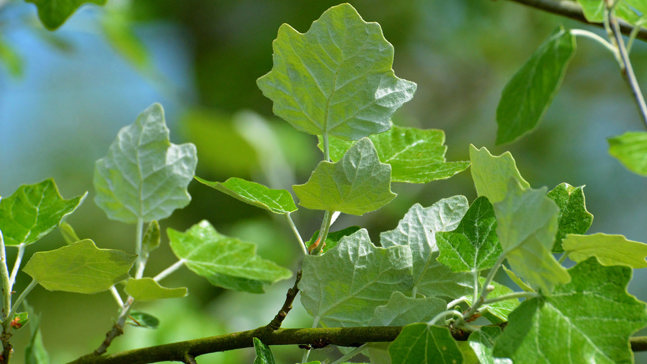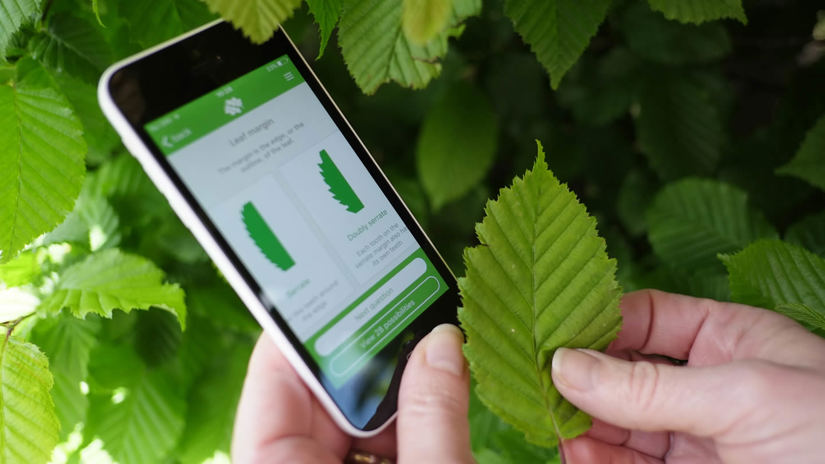
Credit: Louise Fox / Alamy Stock Photo
Leaves
Dark green-grey and whitish on the underside, thanks to a bright white coating of woolly hair. Most leaves have five lobes and have irregular teeth around the edge.
Hardy, pale, magical. White poplar might not be native, but it is naturalised in the UK. It supports early pollinators and is an excellent coastal windbreaker, tolerating salty winds and exposure.
Common name: white poplar
Scientific name: Populus alba
Family: Salicaceae
Origin: non-native
White poplar is a deciduous broadleaf tree which can grow to 20m. The bark is pale grey with lines of black diamond-shaped pores, called lenticels. Twigs are white, and young twigs have a covering of dense white hair that lasts until their second year.
Look out for: the underside of the leaves which is paler than the upper side. The stems of the leaves are also distinctly flattened. It is the whitest tree in the landscape, and from a distance it can appear to be covered in snow.
Identified in winter by: its twigs, especially older ones which are very knobbly. Buds spiral around and are closely pressed to the twig.

Credit: Louise Fox / Alamy Stock Photo
Dark green-grey and whitish on the underside, thanks to a bright white coating of woolly hair. Most leaves have five lobes and have irregular teeth around the edge.

Credit: Panther Media GmbH / Alamy Stock Photo
White poplar is dioecious, meaning male and female flowers are found on separate trees. Flowers are catkins (male catkins are red and female catkins are yellow-green), and are pollinated by wind.

Credit: Blickwinkel / Alamy Stock Photo
Once fertilised, female catkins develop into fluffy, cotton-like seeds, which fall in late summer.
Black poplar (Populus nigra), which has similar twigs. However, the leaves are distinctly different. The buds of white poplar are also hairy, unlike other poplar buds.

Download our free Tree ID app for Android and iPhone to identify the UK's native and non-native trees. It's an A-Z tree guide in your pocket.
Download the appWhite poplar is native to central and southern Europe, Morocco and the Iberian Peninsula. It is naturalised in the UK where it grows in moist conditions, often by water.

Credit: WTML
A variety of moth caterpillars feed on its leaves, including the puss moth, pink-barred sallow, poplar grey, yellow-line quaker, dingy shears and sallow kitten. The catkins are an early source of pollen and nectar for bees and other insects, and the seeds are eaten by birds.
In ancient Roman mythology, the white poplar was consecrated to Hercules after he destroyed Cacus, a fire-breathing giant, next to the Aventine Hill which was covered with white poplars.
People offering sacrifices to Hercules were always crowned with branches of white poplar, and those who conquered their enemies in battle wore white poplar garlands.
White poplar is non-native; but, references to 'Abel' trees in historic documents indicate it has been here for a long time.
White poplar trees are planted as a wind break, particularly on the coast as they can grow in coastal sand and tolerate ocean winds. Suckers grow from the tree’s base which initially give good ground cover and eventually create a dense thicket of trees.
The timber from white popular is very light, though soft and not particularly durable.
The white poplar has historically been used in medicine, particularly its bark which has astringent, antiseptic and anti-inflammatory properties. Taken internally it was used to treat a range of complaints, ranging from rheumatism and digestive problems to lower back pain and gout. Externally, the bark was made into a poultice to treat infected wounds, haemorrhoids and chilblains. Nowadays, the leaves are used to treat tooth decay.
Poplar species can be prone to a variety of fungal diseases, including cankers, leaf rusts and poplar scab.

Shop
We have single trees and tree packs to meet your needs, from wildlife to woodfuel. Delivery is free.
External link

Trees woods and wildlife
Learn more about the pests and diseases threatening our trees. Find out how to spot them, the symptoms and outlook, and how you can help.